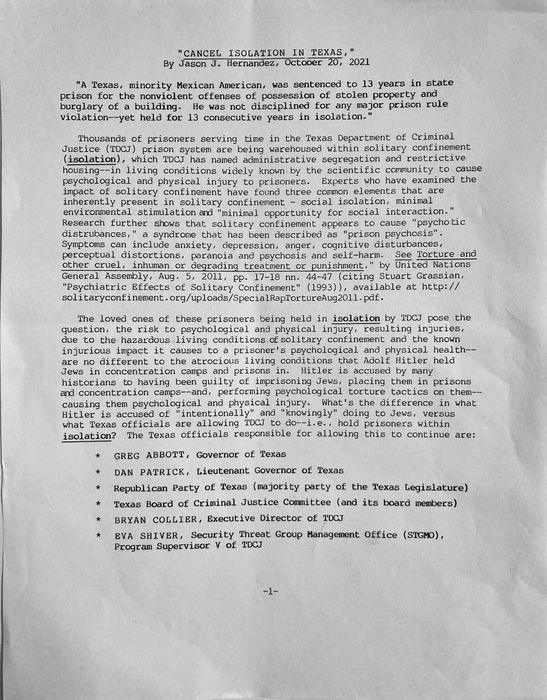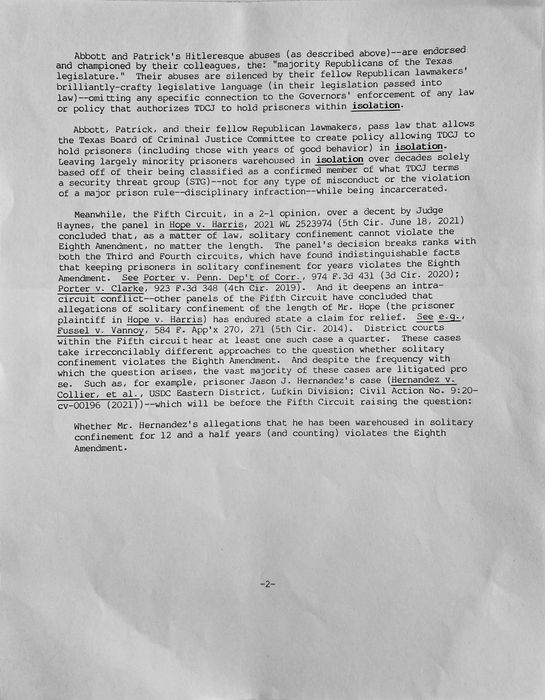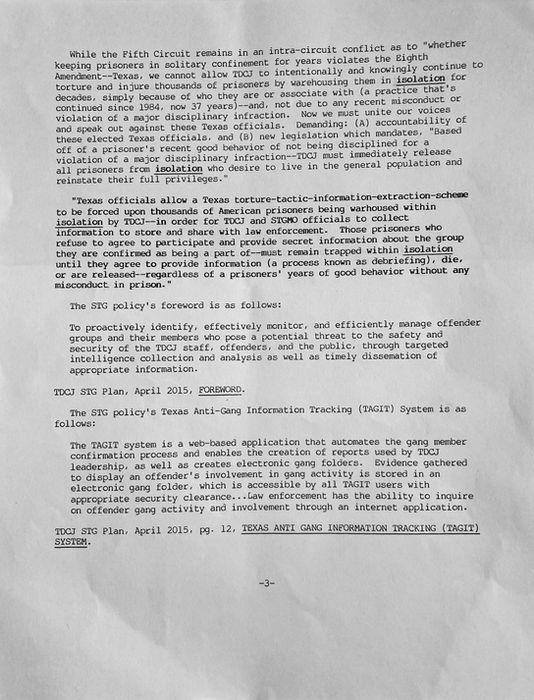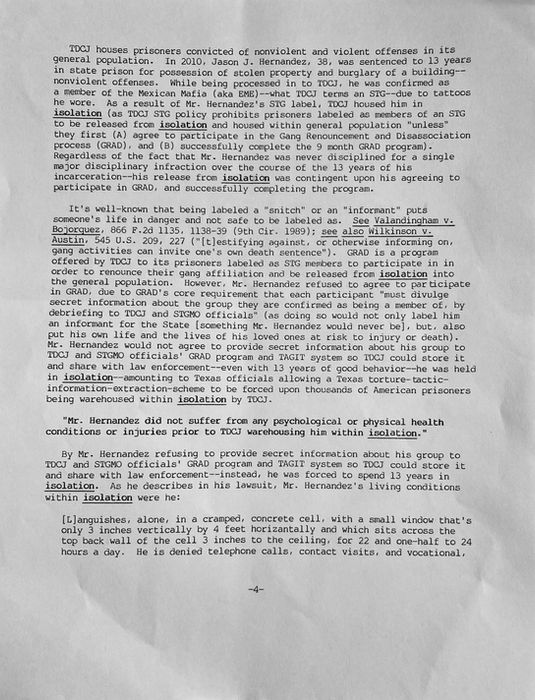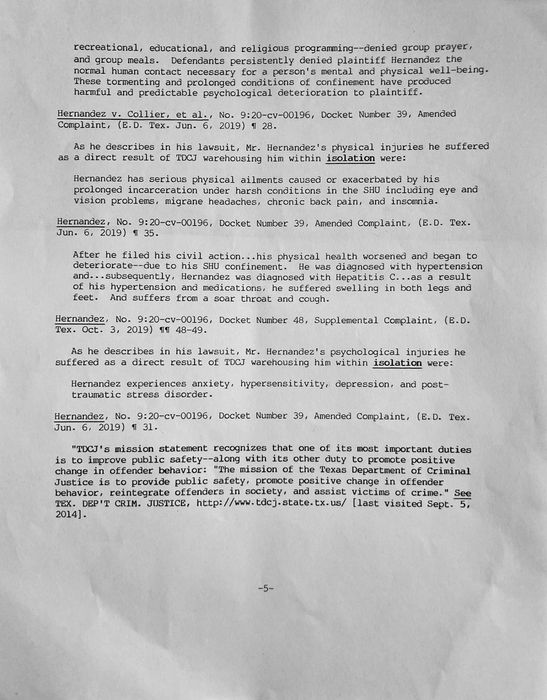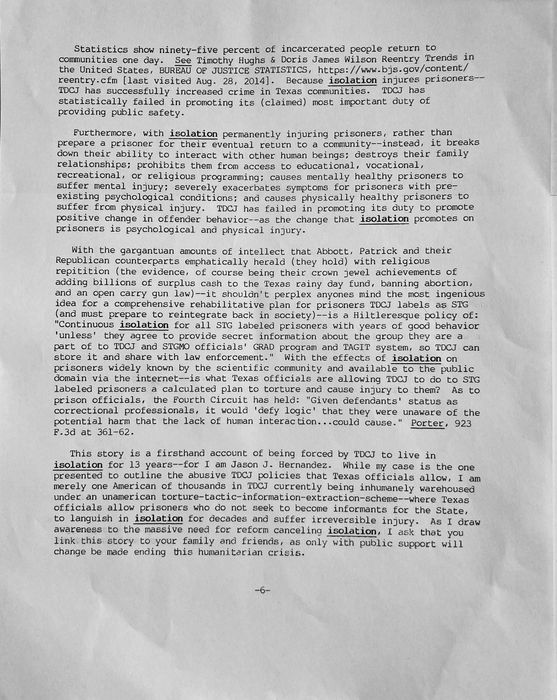“A Texas, minority Mexican American, was sentenced to 13 years in state prison for the nonviolent offenses of possession of stolen property and burglary of a building. He was not disciplined for any major prison rule violation--yet held for 13 consecutive years in isolation.”
Thousands of prisoners serving time in the Texas Department of Criminal Justice (TDCJ) prison system are being warehoused within solitary confinement (isolation), which TDCJ has named administrative segregation and restrictive housing--in living conditions widely known by the scientific community to cause psychological and physical injury to prisoners. Experts who have examined the impact of solitary confinement have found three common elements that are inherently present in solitary confinement - social isolation, minimal environmental stimulation and “minimal opportunity for social interaction.” Research further shows that solitary confinement appears to cause “psychotic disturbances,” a syndrome that has been described as “prison psychosis”. Symptoms can include anxiety, depression, anger, cognitive disturbances, perceptual distortions, paranoia and psychosis and self-harm. See Torture and other cruel, inhuman or degrading treatment or punishment,” by United Nations General Assembly, Aug. 5, 2011, pp.17-18nn. 44-47 (citing Stuart Grassian, “Psychiatric Effects of Solitary Confinement” (1993)), available at LINK.
The loved ones of these prisoners being held in isolation by TDCJ pose the question, the risk to psychological and physical injury, resulting injuries, due to the hazardous living conditions of solitary confinement and the known injurious impact it causes to a prisoner’s psychological and physical health--are no different to the atrocious living conditions that Adolf Hitler held Jews in concentration camps and prisons in. Hitler is accused by many historians to having been guilty of imprisoning Jews, placing them in prisons and concentration camps--and, performing psychological torture tactics on them--causing them psychological and physical injury. What’s the difference in what Hitler is accused of “intentionally” and “knowingly” doing to the Jews, versus what Texas officials are allowing TDCJ to do--i.e., hold prisoners within isolation? The Texas officials responsible for allowing this to continue are:
* GREG ABBOTT, Governor of Texas
* DAN PATRICK, Lieutenant Governor of Texas
* Republican Party of Texas (majority party of the Texas Legislature)
* BRYAN COLLIER, Executive Director of TDCJ
* EVA SHIVER, Security Threat Group Management Office (STGMO), Program Supervisor V of TDCJ
Abbott and Patrick’s Hitleresque abuses (as described above) --are endorsed and championed by their colleagues, the: “majority Republicans of the Texas legislature.” Their abuses are silenced by their fellow Republican lawmakers’ brilliantly-crafted legislative language (in their legislation passed into law) --omitting any specific connection to the Governor’s enforcement of any law or policy that authorizes TDCJ to hold prisoners within isolation.
Abbott, Patrick, and their fellow Republican lawmakers, pass law that allows the Texas Board of Criminal Justice Committee to create policy allowing TDCJ to hold prisoners (including those with years of good behavior) in isolation. Leaving largely minority prisoners warehoused in isolation over decades solely based off of their being classified as a confirmed member of what TDCJ terms a security threat group (STG) --not for any type of misconduct or the violation of a major prison rule--disciplinary infraction--while being incarcerated.
Meanwhile, the Fifth Circuit, in a 2-1 opinion, over a decent by Judge Haynes, the panel in Hope v. Harris, 2021 WL 2523974 (5th Cir. June 18, 2021) concluded that, as a matter of law, solitary confinement cannot violate the Eighth Amendment, no matter the length. The panel’s decision breaks ranks with both the Third and Fourth Circuits, which have found indistinguishable facts that keeping prisoners in solitary confinement for years violates the Eighth Amendment. See Porter v. Penn. Dep’t of Corr., 974 F.3d 431 (3d Cir. 2020); Porter v. Clarke, 923 F.3d 348 (4th Cir. 2019). And it deepens an intra-circuit conflict--other panels of the Fifth Circuit have concluded that allegations of solitary confinement of the length of Mr. Hope (the prisoner plaintiff in Hope v. Harris) has endured state a claim for relief. See e.g., Fussel v. Vannoy, 584 F. App’x 270, 271 (5th Cir. 2014). District courts within the Fifth circuit hear at least one such case a quarter. These cases take irreconcilably different approaches to the question whether solitary confinement violates the Eighth Amendment. And despite the frequency with which the question arises, the vast majority of these cases are litigated pro se. Such as, for example, prisoner Jason J. Hernandez’s case (Hernandez v. Collier, et al., USDC Eastern District, Lufkin Division; Civil Action No. 9:20-cv-00196 (2021))--which will be before the Fifth Circuit raising the question:
Whether Mr. Hernandez’s allegations that he has been warehoused in solitary confinement for 12 and a half years (and counting) violates the Eighth Amendment.
While the Fifth Circuit remains in an intra-circuit conflict as to “whether keeping prisoners in solitary confinement for years violates the Eighth Amendment--Texas, we cannot allow TDCJ to intentionally and knowingly continue to torture and injure thousands of prisoners by warehousing them in isolation for decades, simply because of who they are or associate with (a practice that’s continued since 1984, now 37 years)--and, not due to any recent misconduct or violation of a major disciplinary infraction. Now we must unite our voices and speak out against these Texas officials. Demanding: (A) accountability of these elected Texas officials, and (B) new legislation which mandates, “Based off of a prisoner’s recent good behavior of not being disciplined for a violation of a major disciplinary infraction--TDCJ must immediately release all prisoners from isolation who desire to live in the general population and reinstate their full privileges.”
Texas officials allow a Texas torture-tactic-information-extraction-scheme to be forced upon thousands of American prisoners being warehoused within isolation by TDCJ--in order for TDCJ and STGMO officials to collect information to store and share with law enforcement. Those prisoners who refuse to agree to participate and provide secret information about the group they are confirmed as being a part of--must remain trapped within isolation until they agree to provide information (a process known as debriefing), die, or are released--regardless of a prisoners’ years of good behavior without any misconduct in prison.”
The STG policy’s foreword is as follows:
To proactively identify, effectively monitor, and efficiently manage offender groups and their members who pose a potential threat to the safety and security of TDCJ staff, offenders, and the public, through targeted intelligence collection and analysis as well as timely dissemation of appropriate information.
TDCJ STG Plan, April 2015, FOREWORD.
The STG policy’s Texas Anti-Gang Information Tracking (TAGIT) System is as follows:
The TAGIT system is a web-based application that automates the gang member confirmation process and enables the creation of reports used by TDCJ leadership, as well as creates electronic gang folders. Evidence gathered to display an offender’s involvement in gang activity is stored in an electronic gang folder, which is accessible by all TAGIT users with appropriate security clearance...Law enforcement has the ability to inquire on offender gang activity and involvement through an internet application.
TDCJ STG Plan, April 2015, pg. 12, TEXAS ANTI GANG INFORMATION TRACKING (TAGIT) SYSTEM.
TDCJ houses prisoners convicted of nonviolent and violent offenses in its general population. In 2010, Jason J. Hernandez, 38, was sentenced to 13 years in state prison for possession of stolen property and burglary of a building--nonviolent offenses. While being processed in to TDCJ, he was confirmed as a member of the Mexican Mafia (aka EME)--what TDCJ terms an STG--due to tattoos he wore. As a result of Mr. Hernandez’s STG label, TDCJ housed him in isolation (as TDCJ STG policy prohibits prisoners labeled as members of an STG to be released from isolation and housed within general population “unless” they first (A) agree to participate in the Gang Renouncement and Disassociation process (GRAD), and (B) successfully complete the 9 month GRAD program). Regardless of the fact that Mr. Hernandez was never disciplined for a single major disciplinary infraction over the course of the 13 years of his incarceration--his release from isolation was contingent upon his agreeing to participate in GRAD, and successfully completing the program.
It’s well-known that being labeled a “snitch” or an “informant” puts someone’s life in danger and not safe to be labeled as. See Valandingham v. Bojorquez, 866 F. 2d 1135, 1138-39 (9th Cir. 1989); see also Wilkinson v. Austin, 545 U.S. 209, 227 (“[t]estifying against, or otherwise informing on, gang activities can invite one’s own death sentence”). GRAD is a program offered by TDCJ to its prisoners labeled as STG members to participate in in order to renounce their gang affiliation and be released from isolation into the general population. However, Mr. Hernandez refused to agree to participate in GRAD, due to GRAD’s core requirement that each participant “must divulge secret information about the group they are confirmed as being a member of, by debriefing to TDCJ and STGMO officials” (as doing so would not only label him an informant for the State [something Mr. Hernandez would never be], but, also put his own life and the lives of his loved ones at risk to injury or death). Mr. Hernandez would not agree to provide secret information about his group to TDCJ and STGMO officials’ GRAD program and TAGIT system so TDCJ could store it and share with law enforcement--even with 13 years of good behavior--he was held in isolation--amounting to Texas officials allowing a Texas torture-tactic-information-extraction-scheme to be forced upon thousands of American prisoners being warehoused in isolation by TDCJ.
“Mr. Hernandez did not suffer from any psychological or physical health conditions or injuries prior to TDCJ warehousing him within isolation.”
By Mr. Hernandez refusing to provide secret information about his group to TDCJ and STGMO officials’ GRAD program and TAGIT system so TDCJ could store it and share with law enforcement--instead, he was forced to spend 13 years in isolation. As he describes in his lawsuit, Mr. Hernandez’s living conditions within isolation were he:
[L] anguishes, alone, in a cramped, concrete cell, with a small window that’s only 3 inches vertically by 4 feet horizontally and which sits across the top back wall of the cell 3 inches to the ceiling, for 22 and one-half to 24 hours a day. He is denied telephone calls, contact visits, and vocational, recreational, educational, and religious programming--denied group prayer, and group meals. Defendants persistently denied plaintiff Hernandez the normal human contact necessary for a person’s mental and physical well-being. These tormenting and prolonged conditions of confinement have produced harmful and predictable psychological deterioration to plaintiff.
Hernandez v. Collier, et al., No. 9:20-cv-00196, Docket Number 39, Amended Complaint, (E.D. Tex. Jun. 6, 2019) ¶ 28.
As he describes in his lawsuit, Mr. Hernandez’s physical injuries he suffered as a direct result of TDCJ warehousing him within isolation were:
Hernandez has serious physical ailments caused or exacerbated by his prolonged incarceration under harsh conditions in the SHU including eye and vision problems, migrane headaches, chronic back pain, and insomnia.
Hernandez, No. 9:20-cv-00196. Docket Number 39, Amended Complaint, (E.D. Tex. Jun. 6, 2019) ¶ 35
After he filed his civil action...his physical health worsened and began to deteriorate--due to his SHU confinement. He was diagnosed with hypertension and…subsequently, Hernandez was diagnosed with Hepatitis C...as a result of his hypertension and medications, he suffered swelling in both legs and feet. And suffers from a soar throat and cough.
Hernandez, No. 9:20-cv-00196, Docket Number 48, Supplemental Complaint, (E.D. Tex. Oct. 3, 2019) ¶¶ 48-49.
As he describes in his lawsuit, Mr. Hernandez’s psychological injuries he suffered as a direct result of TDCJ warehousing him within isolation were:
Hernandez experiences anxiety, hypersensitivity, depression, and post-traumatic stress disorder.
Hernandez, No. 9:20-cv-00196, Docket Number 39, Amended Complaint, (E.D. Tex. Jun. 6, 2019) ¶ 31.
“TDCJ’s mission statement recognizes that one of its most important duties is to improve public safety--along with its other duty to promote positive change in offender behavior: “The mission of the Texas Department of Criminal Justice is to provide public safety, promote positive change in offender behavior, reintegrate offenders in society, and assist victims of crime.” See TEX. DEP’T CRIM. JUSTICE, http://www.tdcj.state.tx.us/ [last visited Sept. 5, 2014].
Statistics show ninety-five percent of incarcerated people return to communities one day. See Timothy Hughs & Doris James Wilson Reentry Trends in the United States, BUREAU OF JUSTICE STATISTICS, https://www.bjs.gov/content/reentry.cfm [last visited Aug. 28, 2014]. Because isolation injures prisoners--TDCJ has successfully increased crime in Texas communities. TDCJ has statistically failed in promoting its (claimed) most important duty of providing public safety.
Furthermore, with isolation permanently injuring prisoners, rather than prepare a prisoner for their eventual return to a community--instead, it breaks down their ability to interact with other human beings; destroys their family relationships; prohibits them from access to educational, vocational, recreational, or religious programming; causes mentally healthy prisoners to suffer mental injury; severely exacerbates symptoms for prisoners with pre-existing psychological conditions; and causes physically healthy prisoners to suffer from physical injury. TDCJ has failed in promoting its duty to promote positive change in offender behavior--as the change that isolation promotes on prisoners is psychological and physical injury.
With the gargantuan amounts of intellect that Abbott, Patrick and their Republican counterparts emphatically herald (they hold) with religious repitition (the evidence, of course being their crown jewel achievements of adding billions of surplus cash to the Texas rainy day fund, banning abortion, and an open carry gun law)--it shouldn’t perplex anyones mind the most ingenious idea for a comprehensive rehabilitative plan for prisoners TDCJ labels as STG (and must prepare to reintegrate back into society)--is a Hitleresque policy of: “Continuous isolation for all STG labeled prisoners with years of good behavior ‘unless’ they agree to provide secret information about the group they are a part of to TDCJ and STGMO officials’ GRAD program and TAGIT system, so TDCJ can store it and share with law enforcement.” With the effects of isolation on prisoners widely known by the scientific community and available to the public domain via the internet--is what Texas officials are allowing TDCJ to do to STG labeled prisoners a calculated plan to torture and cause injury to them? As to prison officials, the Fourth Circuit has held: “Given defendants’ status as correctional professionals, it would ‘defy logic’ that they were unaware of the potential harm that the lack of human interaction...could cause.” Porter, 923 F.3d at 361-62.
This story is a firsthand account of being forced by TDCJ to live in isolation for 13 years--for I am Jason J. Hernandez. While my case is the one presented to outline abusive TDCJ policies that Texas officials allow, I am merely one American of thousands in TDCJ currently being inhumanely warehoused under an unamerican torture-tactic-information-extraction-scheme where Texas officials allow prisoners who do not seek to become informants for the State, to languish in isolation for decades and suffer irreversible injury. As I draw awareness to the massive need for reform canceling isolation, I ask that you link this story to your family and friends, as only with public support will change be made ending this humanitarian crisis.
Finally, with 12 and a half years served on my 13 year sentence--5 months left to serve before being forced to discharge my entire sentence and be freed back into society--what I find constantly lingering on my mind is: “My past 13 years--lost. My injuries sustained within isolation--irreversible. My future prosperity and self-sufficiency upon my soon release back into society--uncertain.”

Polunsky Unit, Livingston, Texas
11 years in solitary / ad seg
Jason J.
HERNANDEZ
October 20, 2021
Words by JASON J. HERNANDEZ
Photography by TEXAS LETTERS










